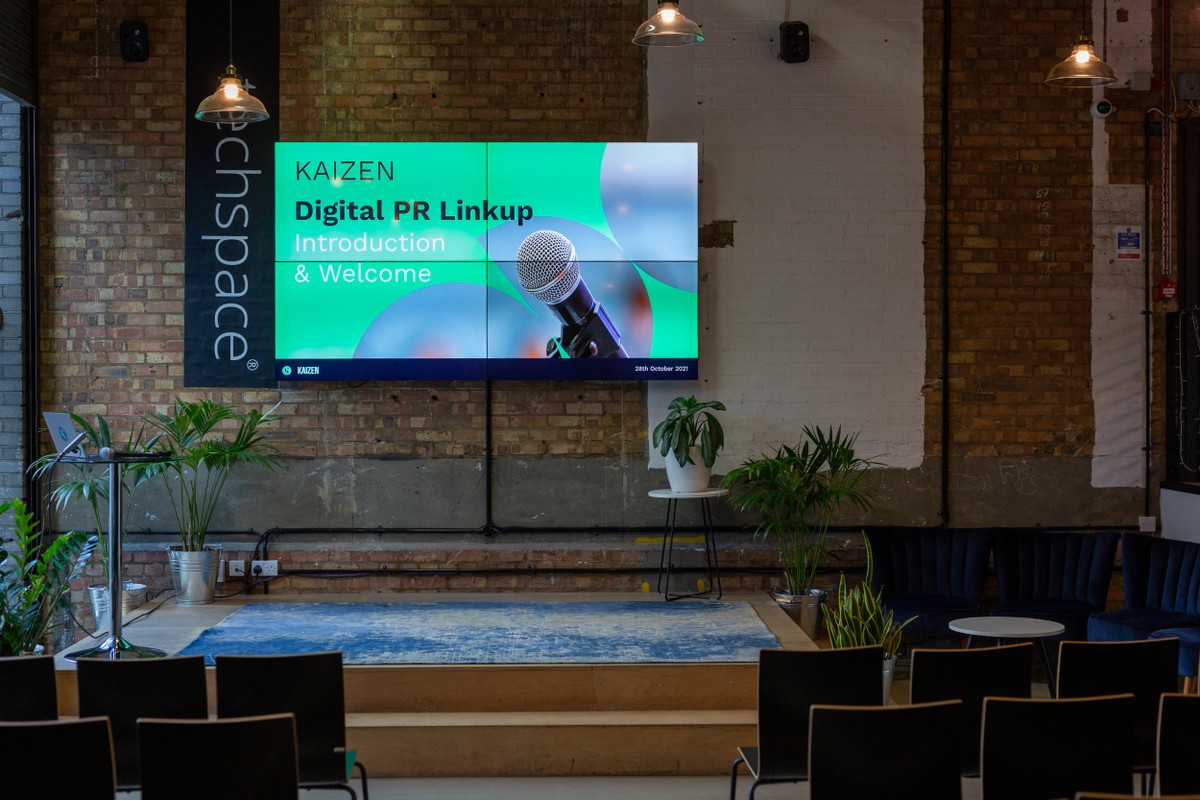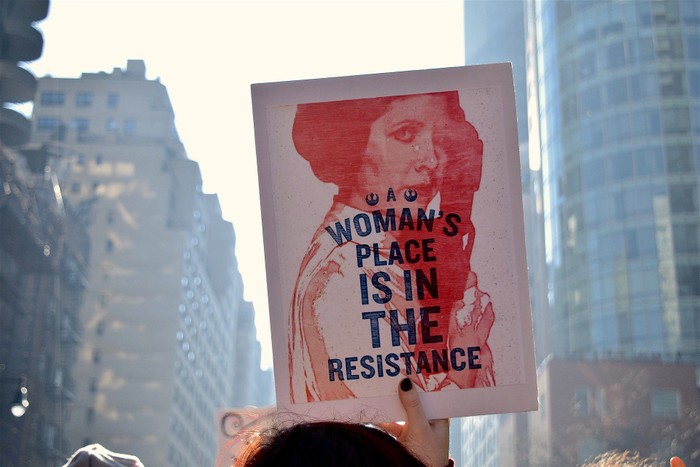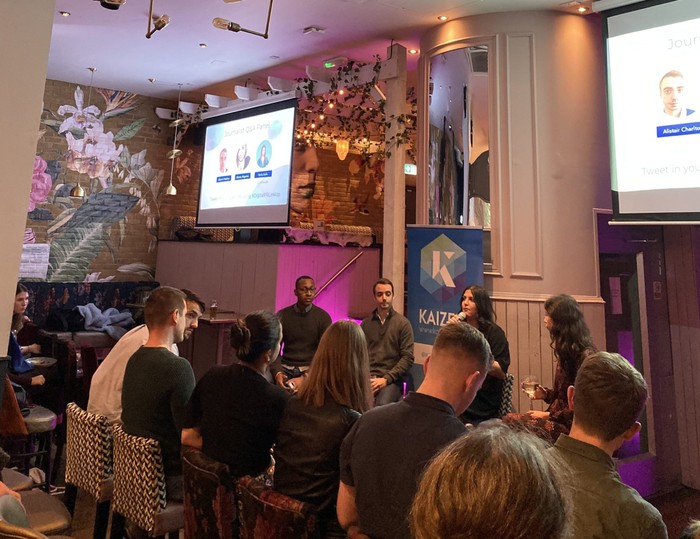Conferences & Events
Kaizen’s Digital PR Linkup 2021

The day we’d all been waiting for finally arrived on 28th October 2021. Our first in-person event in what felt like forever, and it was a great success! We had four key speakers, who all gave inspirational and helpful talks to our audience.
The first speaker of the day was our very own, Marina Plummer. Marina is our Senior Digital PR Manager and gave a fantastic talk, all about keeping it fresh. She highlighted the challenges we’ve faced, the changes digital PR has seen since 2017, key factors that have transformed our client offers, and how to produce a fresh and bespoke strategy for brands.
One key factor that Marina shared that has transformed our client offering is reactive PR. She kindly gave some tips on how to be successful when it comes to reactive PR and ways to get case studies and expert commentary. These include ResponseSource, friends and family, manually researching experts and social media.
There’s a lot of debate in the industry about the value of no-follow links and brand mentions. Marina spoke about this and highlighted that Google is becoming more advanced, and therefore it is recognising and using these as hints when it comes to rankings and authority. The most important thing is communication with our clients and explaining to them that it’s not all about follow links.
Playing it safe isn’t enough anymore. We are online marketers, not just digital PRs. Looking back to 2017, Marina adds that our industry is almost unrecognisable. It began as a link-targeted strategy, but today it’s more about having a bespoke strategy.
Marina also covered how to produce a bespoke strategy. Start with a blank canvas and put the brand at the heart of it. So, how do you do this? She reminds us of the things we should consider when putting the brand at the heart of the strategy. These include:
- What are the objectives?
- What’s their messaging and voice?
- Who are their competitors?
- What’s the quality of existing backlinks?
- What pages and keywords are they looking to improve?
- What are the challenges?
- What areas of online marketing will be the most effective?
Additionally, Marina reminded us that digital PR is more than just linking; it’s also about relevance and engagement. Think about what the client wants. Is it links? Is it social shares? Is it an increase in traffic?
Marina rounded up her talk with a case study about Doop Toothbrush. Kaizen pitched to Doop in May 2021 and started with a blank canvas; Marina spoke through our goals and explained how we came up with the ideas and the end goal.
To summarise:
- Diversity is key.
- News always has been the main inspiration.
- Work more closely with the client.
- Start with a blank canvas.
- Think like a marketer and explore new avenues.
- Align with Google standards.
Next up, we had a talk from Kirsten Beacock at Lastminute.com – Link building: How to Sell the Idea to Your CMO and Manage Your Agency.
To kick things off, Kirsten spoke about the difference between traditional PR and digital PR, highlighting that traditional PR is more than online; it’s radio, podcasts, events, etc.
Kirsten gave the audience numerous tips on how to sell the idea to your Chief Marketing Officer (CMO) and manage your agency.
Kirsten’s first tip when trying to sell to your CMO is to treat it like a pitch. An agency has sold an idea to you; now it’s your turn to sell it and get it approved. You also need to identify stakeholders. Consider who needs to know.
Additionally, Kirsten explained the importance of a good brief. The devil is in the details; think about the key objectives, business objectives, and barriers you may encounter. You want to ensure that the CMO is aware of everything.
Other things to consider covering in your pitch are:
- The brand, its audience, and media targets.
- Onsite pages, the business insight, its tone of voice, the format of the site.
- Extras: Do they have a spokesperson who can be the contact for reactive PR? What owned data do they have? What are the business KPIs?
Kirsten also had a word of advice specific to agencies! She says to be flexible, have a pre-pitch call, keep ideas relevant – there’s no point showcasing a good campaign you did five years ago; show new ones. Finally, don’t have a fantasy organisation chart; be truthful on who will be working on the campaign.
Kirsten adds to not forget that real results take time.
Ways to look at success include:
- Number of backlinks
- Long-term growth
- Rankings/conversions
And the biggest sign that an agency has done a good job is clients coming back to work with you again!
Some final tips from Kirsten are:
- Be clear in your idea – why & what
- Work together for optimum results
- PR the project internally and externally
Question time! At the end of the talks, the audience was given the opportunity to ask questions:
How would you approach a journalist?
Cultivate direct relationships and have someone ready at all times, especially with reactive PR. Also, if you can, it’s good to meet them for a drink or lunch and build a genuine relationship.
What do you wish agencies did more?
Truly understood the brand. However, the client does have to ensure that the agency is absolutely clear on who the brand is, what they do etc. It isn’t solely up to the agency. Communication from the brand is absolutely key.
Our third speaker of the day is Hannah Ajala, a BBC journalist who spoke to us about how to sell yourself the right way.
To begin, Hannah spoke through the role of a journalist and what it takes to become a successful one. Following this, Hannah gave our audience some great tips on how to sell yourself and your story the right way!
Firstly, effective branding and networking are vital! Find out who you are already connected to on socials; research them. Do they know much about you? Do you have a clear understanding of their work?
Hannah adds that most journalists won’t have more than 2 or 3 minutes to read through an email, so make it short, to the point and informative. Don’t send an unrelated email – research and understand their background.
A good story is something eye-catching, informative, engaging, and one that immediately has a key audience in mind, says Hannah.
Another tip is to research the organisation and their stories. It’s good to know what would work for them, have different templates/angles for different publications, and ask yourself, how will they benefit from what you bring?
Other tips from Hannah include:
- When reaching out to a journalist, consider whether it actually sells a story or just an advertisement?
- Build a relationship; actually, keep in touch with them. Keep it authentic and genuine; it’s easy to spot a fake. Refer and share their work.
- Less of the brand, MORE of the story. What’s the narrative?
- If you can create a story from two to three lines, it’s worth looking into.
- Think about whether you can see the story actually sitting on some websites you’ve researched. If you can’t, don’t reach out to them.
Question time – Hannah received many questions from our Founder and CEO, Pete, and people in the audience.
What makes the cut?
Create a story in three lines. Keep it short and sweet. If you can do that, it’s worth looking into.
What about a press release?
Attach it. But focus more on the body of the email. Journalists will open a press release if they’re interested in the initial email.
Do follows up work? Is it worth it? Is it annoying?
After three attempts to contact them, it’s not meant to be. The first follow up should be 5-7 working days. The second attempt should be 7-10 days. If you’ve not heard back by then, they aren’t interested.
Is there a right time of day to get in touch?
For me personally, 8 am is a good time. I’d avoid 11 – 1 pm. 2 pm onwards is also fine.
Do you respond on Twitter?
Yes, I do, my DMs are open, and I do check them out. It is a good way to outreach.
Is an email pitch best from an agency or the brand?
If you have access to brand email, do it through that. It’s attractive; it’s clickbait.
Hannah finishes her talk by highlighting the importance of building relationships! You don’t want to come off as a cold call.
To round off the day’s talks, we had an excellent talk from another one of our own, Lottie Maddison! This was Lottie’s first-ever in-person talk, and she did absolutely brilliantly.
Lottie’s talk was all about how to be an advocate and an ally for the LGBTQ+ community, and how brands can truly support them and avoid boycotts and backlashes.
To start, Lottie talked us through the history of the LGBTQ+ community and emphasised that although a lot of good has happened in recent years, for example, section 28 was revoked and the legalisation of same-sex marriage, there’s still a lot to fight for.
Younger generations and those part of the LGBTQ+ community are willing to support brands that support them and boycott brands that don’t. Lottie gives us several examples of brands doing a great job and highlights where brands go wrong.
Lottie raised an important point that rainbows aren’t just a logo to be used during Pride month (June in the UK). The community exist 12 months of the year. It’s a lovely start, and it’s not a bad thing. However, if that’s all you do, it’s not good.
To showcase a brand that is doing a great job supporting the community, Lottie used Lego as a case study. On their landing page, they had a video explaining and addressing the community’s struggles and importance. They promoted alongside lots of interviews with employees and fans and also had interactive challenges.
Additionally, Lottie stressed not to use Pride month for monetary gain. People know when it’s fake. A way a brand can showcase that its support isn’t for monetary gain is to donate to an LGBTQ+ cause. 2 out of 5 brands don’t do this, which is a huge red flag!
Some brands that do this include:
- Ralph Lauren – all proceeds of its Pride collection went to Stonewall.
- Doc Martens – goes beyond pride month. They make an annual donation to The Trevor Project.
- Disney – support charities globally with their pride collections.
- Converse – donate and showcase LQBTQ+ artists. Additionally, all pride collection proceeds went to It Gets Better.
Another tip that Lottie shared with the audience is to start using a diverse range of influencers that represent our society. Of course, feature straight, white slim females, but just not all the time. Society is not made up of one person, so don’t just market to one person. If people don’t recognise themselves in the branding, it’s unlikely they’ll buy from it.
Brands have much more to lose, than gain, by alienating minorities, so try to make them relate to the content.
At the end of her talk, Lottie gave the audience time to reflect. What is your brand or company?
Silent, an ally or an advocate?
Being an ally is good but being an advocate is better. You may get it wrong, but if you do acknowledge your mistake, say sorry and do better next time. If you’re not sure, ask a colleague from the community if it’s okay. Educate yourself; listen to podcasts, read articles, follow influencers and thought leaders within the community. Representation in your stories is so important. Make it natural.
She also kindly gave us a bonus tip and reminded us not to end up like National Express. Perhaps run content past someone from the community and also check out the urban dictionary meaning of certain words!
Question time:
Who could we follow?
Me. (@lottie.kaizen) and also Ellen Jones. She is @ellen___jones on Instagram.
How can we help?
Ensure you have aftercare for people from the LGBTQ+ community. If you are featuring them, you do have a duty of care as you’re putting them in the spotlight, and we all know the internet can be a mean place!
What can brands do to move from ally to advocate?
It all starts from inside the company. Make sure they’re inclusive. Healthcare? Bathrooms? Time off for appointments? If you have no one from the community working with you, look into why. Are you making it clear that you support us? Once you’ve got it on the inside, it’ll filter out to the outreach.
Following all our talks, we had some time for networking and connecting with other great PRs from various agencies!
Stay up to date with our upcoming events by subscribing to our updates.
Share









